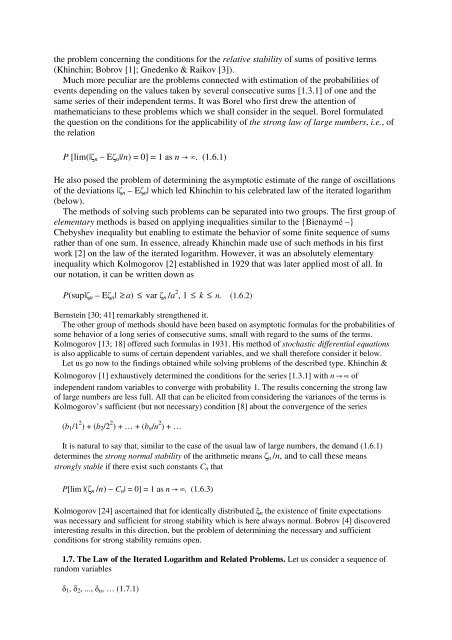7. Probability and Statistics Soviet Essays - Sheynin, Oscar
7. Probability and Statistics Soviet Essays - Sheynin, Oscar
7. Probability and Statistics Soviet Essays - Sheynin, Oscar
Create successful ePaper yourself
Turn your PDF publications into a flip-book with our unique Google optimized e-Paper software.
the problem concerning the conditions for the relative stability of sums of positive terms(Khinchin; Bobrov [1]; Gnedenko & Raikov [3]).Much more peculiar are the problems connected with estimation of the probabilities ofevents depending on the values taken by several consecutive sums [1.3.1] of one <strong>and</strong> thesame series of their independent terms. It was Borel who first drew the attention ofmathematicians to these problems which we shall consider in the sequel. Borel formulatedthe question on the conditions for the applicability of the strong law of large numbers, i.e., ofthe relationP [lim(| n – E n |/n) = 0] = 1 as n . (1.6.1)He also posed the problem of determining the asymptotic estimate of the range of oscillationsof the deviations | n – E n | which led Khinchin to his celebrated law of the iterated logarithm(below).The methods of solving such problems can be separated into two groups. The first group ofelementary methods is based on applying inequalities similar to the {Bienaymé –}Chebyshev inequality but enabling to estimate the behavior of some finite sequence of sumsrather than of one sum. In essence, already Khinchin made use of such methods in his firstwork [2] on the law of the iterated logarithm. However, it was an absolutely elementaryinequality which Kolmogorov [2] established in 1929 that was later applied most of all. Inour notation, it can be written down asP(sup| n – E n | ≥ a) ≤ var n /a 2 , 1 ≤ k ≤ n. (1.6.2)Bernstein [30; 41] remarkably strengthened it.The other group of methods should have been based on asymptotic formulas for the probabilities ofsome behavior of a long series of consecutive sums, small with regard to the sums of the terms.Kolmogorov [13; 18] offered such formulas in 1931. His method of stochastic differential equationsis also applicable to sums of certain dependent variables, <strong>and</strong> we shall therefore consider it below.Let us go now to the findings obtained while solving problems of the described type. Khinchin &Kolmogorov [1] exhaustively determined the conditions for the series [1.3.1] with n ofindependent r<strong>and</strong>om variables to converge with probability 1. The results concerning the strong law¡of large numbers are less full. All that can be elicited from considering the variances of the terms isKolmogorov’s sufficient (but not necessary) condition [8] about the convergence of the series(b 1 /1 2 ) + (b 2 /2 2 ) + … + (b n /n 2 ) + …It is natural to say that, similar to the case of the usual law of large numbers, the dem<strong>and</strong> (1.6.1)determines the strong normal stability of the arithmetic means n /n, <strong>and</strong> to call these meansstrongly stable if there exist such constants C n thatP[lim |( n /n) – C n | = 0] = 1 as n¡ . (1.6.3)Kolmogorov [24] ascertained that for identically distributed n the existence of finite expectationswas necessary <strong>and</strong> sufficient for strong stability which is here always normal. Bobrov [4] discoveredinteresting results in this direction, but the problem of determining the necessary <strong>and</strong> sufficientconditions for strong stability remains open.1.<strong>7.</strong> The Law of the Iterated Logarithm <strong>and</strong> Related Problems. Let us consider a sequence ofr<strong>and</strong>om variables 1 , 2 , ..., n , … (1.<strong>7.</strong>1)









